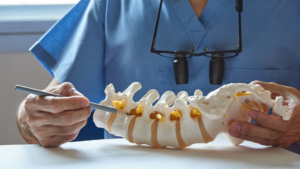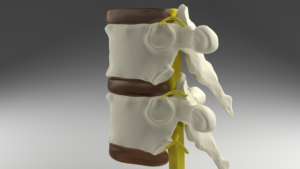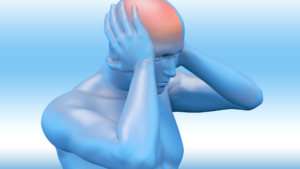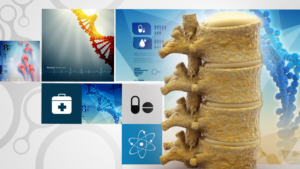Degenerative disc disease (DDD) describes a group of symptoms that results from age-related wear-and-tear of the spinal discs. It could also be a result of an acute spinal injury that causes the spinal column to deteriorate or break down.
Despite its name, degenerative disc disease is, in fact, not a disease. This is a natural occurrence that is a result of aging. The rubber-like discs between the vertebrae that act like shock absorbers allow for bending and flexing of the back. Overtime, they become worn out and are unable to provide the highest level of protection. MRIs show some deterioration of the spine in the majority of patients over the age of 60.

How to Treat Degenerative Disc Disease
Symptoms of DDD
Symptoms are dependent on which disc is degenerated. The most common early sign is pain and weakness in the back that oftentimes radiates to another area. The pain can be weak to the point where it is almost nonexistent or very severe, preventing a person from continuing daily activities. Even if a person typically only has weak or dull pain, they may experience flare ups of extremely intense pain.
Pain may worsen throughout the day, due to bending, sitting, standing, and walking. Changing positions and continuing to move carefully can help prevent the pain from getting more intense.
The pain begins with damage in the spine, but overtime, the discomfort can result in other conditions such as osteoarthritis. Because the pain radiates to other areas of the body, people tend to feel pain and discomfort in their buttocks and upper thigh and tingling in the legs or feet.
When the degenerated disc is in the cervical spine, the neck area, the pain can radiate to the shoulder, arm, or hand.
Another symptom that is possible is for people to experience spinal instability, leading to muscle spasms in the lower back as the body tries to correct and stabilize the vertebrae. These spasms can be very painful.
Treatment Options for Degenerative Disc Disease
Treatment for degenerative disc disease generally begins with nonsurgical methods. Your doctor will determine the severity of the condition and recommend treatment methods based on your individual pain.
Nonsurgical Treatments Options
- Medications: Your physician may suggest taking NSAIDs or over-the-counter pain relievers such as aspirin or ibuprofen. These help inflammation that can ease your pain and lessen swelling.
- Physical Therapy: A physical therapist can help teach proper exercises to strengthen and stretch the correct muscles that help the back heal. Learning movement modifications to everyday tasks can help prevent painful flare-ups. Specific movements make the muscles in the neck and back stronger and more flexible, allowing better spinal support.
For most patients, physical therapy, in conjunction with pain medication, is enough long-term pain relief.
Surgical Treatment Options
If noninvasive treatment options do not work or if a person continues to experience severe pain, your physician may recommend surgery.
Surgery may include the removal of the degenerated disc, which is then replaced with a new disc. Another option is a partial disc removal (discectomy) to help relieve pressure from your nerves.
If there is a severe issue, your doctor may permanently connect (fuse) the bones in your spine after the disc is removed. This will reduce the movement in the damaged area.
Along with following your doctor’s treatment recommendations, self-care goes a long way in reducing pain and strengthening your spine. Physical activity and healthy lifestyle choices like a balanced diet, reducing mental and emotional stress, and stopping smoking have profound effects on this type of musculoskeletal condition.
If you have back pain or are suffering from degenerative disc disease, fill out the form below to get in touch wth the team at Progressive Pain Management.
Neuropathic pain is a type of pain where the cause is not found in an organ or tissue and can occur in any part of the body. This type is most common in the limbs but can also occur in joints, stomach, or elsewhere. It occurs when nerve cells are damaged or injured, sending signals to be felt as pain, usually through burning, prickling, and tingling sensations. Neuropathic pain can be complicated to treat because it cannot always be easily located like other types of pain.

Things to Know About Neuropathic Pain
Causes of Neuropathic Pain
Nerve Damage or Injury
Neuropathic Pain can occur when the nerve cells are damaged or injured. This may happen as a result of disease or damage to the nerves. It may also occur when the protective covering surrounding the nerve fibers are damaged.
Degeneration
Neuropathic Pain can be caused by degeneration of specific brain cells or spinal cord cells, which send pain signals to the brain. This type of Pain is often due to dementia, Parkinson’s disease, multiple sclerosis, spinal injury, and diabetes.
Compression of the Spinal Cord
Occurs when a person is experiencing a fracture or vertebral compression in the neck, chest, or back. The most common Pain that can occur with this maintenance is referred to as radiculopathy and is characterized by sharp shooting pains that run down the arms, legs, and back.
How to treat neuropathic Pain
The main goal of treating neuropathic Pain is to manage the pain as much as possible and to reduce the side effects of the treatment. People with neuropathic Pain may be referred to standard medication such as:
Opioids
A class of drugs that relieve Pain by suppressing the central nervous system’s response to pain signals. Examples include hydrocodone (Vicodin) and codeine. Medications like these slow the nerves down, making them less sensitive to pain signals.
Anticonvulsant
These medicines constrict the muscles in the brain by reducing abnormal neuron activity or abnormal neuron growth. Examples include carbamazepine (Tegretol), valproic acid (Depakote) and gabapentin (Neurontin).
NSAIDs(Non-steroidal anti-inflammatory drugs)
These painkillers are most commonly used to treat inflammation and swelling, but they also reduce the effects of nerve damage by suppressing the central nervous system’s response to pain signals.
Acupuncture
Acupuncture is a method that involves placing wonderful needles into acupuncture points and in the back to try to curb pain signals from being sent out. Acupuncture can help reduce a person’s sensitivity to Pain by blocking the nerves and nerve pathways.
Transcutaneous electrical nerve stimulation (TENS)
Treatment involves placing electrodes on the skin and pressing them to send signals to particular nerve pathways. TENS can be used as a treatment for Pain that conventional therapies cannot control.
Rehabilitation
When Pain becomes severe and chronic, severe Pain should be treated first. Treatments after that may include rehabilitation therapies. These include physical therapy, which can help improve mobility and strength, cognitive behavioral therapy, which can help to decrease stress and anxiety related to Pain, and psychotherapy, which can also help reduce stress as well as depression or other emotional problems related to the Pain or different multidisciplinary approaches such as educational programs.
Final Thoughts
Neuropathic Pain is a type of Pain that many people suffer from at one point in their lives. In most cases, Pain can be managed with various treatments and medications.
If you suffer from neuropathic pain that conventional treatments cannot control, Progressive Pain Management is here to help you. Fill out the form below to contact our team for further queries.
Have you or a loved one been experiencing chronic pain for months in your lower body? If so, you may want to consider DRG Therapy, a new treatment method for chronic pain. This blog post explains what DRG Therapy is, who’s a good candidate for it, what you can expect from the treatment, and the next steps you can take.

DRG Therapy for Chronic Pain
What is DRG Therapy?
DRG Therapy stands for Dorsal Root Ganglion Stimulation therapy. According to Penn State Health, a dorsal root ganglion is a collection of sensory neurons at the dorsal root of a spinal nerve. DRGs act like traffic lights, managing the signals and sensations that travel along the spinal column to the brain.
DRG therapy is a type of neurostimulation therapy. This means using invasive and noninvasive techniques and the application of electrical stimulation to drive neural function. Stimulation can ease the pain in specific locations. DRG Therapy is for managing chronic pain in specific areas of the lower body like your:
- foot
- knee
- hip
- pelvis
- groin
While there isn’t a cure for isolated chronic pain, DRG therapy can provide some much-needed relief in those areas. It’s particularly beneficial for those who suffer from chronic pain in the pelvis and lower body.
Are You a Candidate?
You may want to consider DRG therapy if you’re experiencing:
- Chronic pain in a lower part of the body, like your foot, knee, hip, or groin after an injury or surgery.
- Chronic pain that lasts six months or more.
- Minimal or no relief from pain management therapies or traditional neurostimulation, medications, or surgery.
- Only partial relief from other therapies.
What Can You Expect from This Treatment?
The therapy involves a physician implanting a temporary and removable device, i.e., the DRG stimulator. The doctor will work with you to try out the device to see if it can effectively manage your pain before they implant it.
Once implanted, the physician uses a patient “remote control” to send mild electrical pulses from the stimulator to your dorsal root ganglia. The result should be pain relief in the targeted area.
Relieve Chronic Pain and Take Back Your Life
No one should live with continual, daily pain. DRG Therapy is unique because it’s a spinal stimulation concentrating on the lower body area. Relieve the pain so you can live the happy, productive life you deserve.
If you or a loved one has been experiencing chronic pain and are interested in DRG Therapy, Progressive Pain Management is here to help. In addition to DRG Therapy, we offer a wide variety of other pain management treatments and programs. Contact us today, and we’re happy to answer your questions about pain management and help you set up an appointment.
Epidural steroid injections (ESI) are a minimally invasive procedure performed to help reduce inflammation and pain caused by nerve root compression. Herniated discs, bone spurs, or spinal stenosis cause nerve compressions. Pain, numbness, or weakness along the nerve are symptoms of nerve compression, referred to as radiculopathy. This pain can last for days or even years if left untreated.
An epidural steroid injection aims to help reduce inflammation along the nerve root. Medication is injected in the fat-filled area between the bone and the protective layer of the spinal nerve, called the epidural space. These injections are intended to reduce pain so that normal activity and a physical therapy program can be resumed.

What is an Epidural Steroid Injection
What is an Epidural Steroid Injection?
There are multiple types of steroid injections, most commonly described according to where they are injected. Steroid injections in the neck are called cervical epidural injections. Injections performed in the middle back are thoracic epidural steroid injections, and injections in the lower back are lumbar epidural injections.
The injections can also be labeled according to the direction of the needle. Most epidural steroid injections are placed between the lamina. This is called an interlaminar epidural steroid injection. The needle is aimed upwards toward the head and goes in between two laminae. Another type of injection is a transforaminal steroid injection. The needle travels along the course of a nerve and enters the spine from a diagonal direction. A caudal approach to ESIs allows the needle to enter directly into the epidural space through the sacral hiatus – a small boney opening directly above the tailbone.
The steroid injection contains a corticosteroid, such as triamcinolone, methyl-prednisolone, or dexamethasone, and an anesthetic numbing agent like lidocaine. They are injected into the area between the vertebra and the protective sac surrounding the spinal cord and nerves.
Why Are They Used?
These steroid injections are used in patients who suffer from pain in the neck, arm, lower back, or have sciatica. This treatment has proven beneficial to those with severe inflammatory conditions. Patients who have the following conditions are candidates for epidural steroid injections:
- Spinal Stenosis – a narrowing of the spinal canal and nerve root canal
- Herniated Disc – the material inside a disc can bulge or rupture through a weak area in the cartilage and come in contact with a spinal nerve.
- Degenerative Disc – breakdown or aging of a spinal disc causing the disc space to collapse or growth of bone spurs.
- Sciatica – compression of nerves that causes pain to travel into the buttocks and down the legs.
In some cases, ESI can be used to determine whether surgery will be successful in patients who have a herniated disc. The injections can ease pain enough so a physical therapy routine can be established.
Risks Involved with Epidural Steroid Injections
ESI procedures have been performed for many years and is considered a safe and effective treatment. Although uncommon, some patients do experience side effects from the medication. Patients may experience a “steroid flush” which is a flushing of the face and chest that can be accompanied by a low-grade fever.
Other side effects may include:
- Trouble sleeping
- Temporary water retention
- Anxiety
Serious complications are very rare, but could include an allergic reaction to the contrast dye, infection, nerve damage, or bleeding. When this procedure is performed with fluoroscopic guidance, the risk is minimized. Generally, this type of procedure and injection is very well tolerated by most patients.
To learn more about epidural steroid injections and how they can help back pain, fill out the form below:
Facet joints are small, bony joints that sit along the spine. They are paired up from the neck to the lower back area. When the joints get inflamed, they cause pain that can be severe. The pain can be acute or chronic, caused by a variety of conditions.
The pain radiates to other parts of the body and causes indirect pain. For pain that starts in the lower back, it’s common for the pain to move to the thighs and buttocks. If the pain starts in the neck or upper back region, it can transfer to the shoulders, and arms, and even cause headaches.

Facet Joint Injections for Chronic Pain
What is a Facet Joint Injection?
The injection is a strong anti-inflammatory steroid that gets inserted into the facet joint. The medication is a mixture of a local anesthetic and a steroid, similar to a cortisone injection. Before performing the injection, your doctor will explain the procedure, have you sign all the appropriate consent forms, and then have you lie on your stomach.
The procedure is minimally invasive. X-ray guidance is used to locate the facet joints and helps guide the needle to the exact location. The actual injection only takes a few minutes, but you may want to allow for additional recovery time depending on the type of anesthetic you choose. Some doctors will let you choose a local anesthetic or a stronger general anesthetic. The general anesthetic may cause drowsiness and sedation will take longer to wear off.
What to Expect After the Injection?
Right after the injection, you will feel relief from pain. That is due to the anesthetic in the injection, and only lasts for a few hours. The injection site may become sore after a few days, and the pain is not uncommon to resume the day after the injection. About 1-2 days after the injection, the medication will begin to take effect and help reduce your pain on a daily basis.
It is advised to take it easy following the injection and only to resume normal activity when it is comfortable to do so. Your doctor may recommend applying ice to the injection site. This will help reduce any swelling and soreness following the procedure.
How Long Does a Facet Joint Injection Last?
Immediately following the injection, you may feel lessened pain. However, this is temporary relief until the medication kicks in. That can take between 2-7 days after the injection.
If the first injection is successful in managing your pain, your doctor may perform additional injections. The amount of relief depends on your specific pain and because there are a variety of pain receptors in the spine, the long-term effect of these injections cannot be predicted. Everyone’s pain is different, so the treatment effectiveness will vary.
There are very few risks associated with this type of injection. The most common being tenderness and pain at the injection site, although this is temporary. Side effects of steroids may include weight gain, water retention, and temporary increase in blood sugar.
Facet joint injections are an excellent alternative to undergoing serious back surgery. Talk with your doctor today to discuss your options for getting relief from your pain and taking one step closer to bettering your quality of life.
Risks Associated with the Facet Joint Injection Procedure
As with any type of injection or invasive procedure, there are certain risks or complications that could arise:
- Allergies: In most cases, the allergic reaction is caused by the X-ray contrast or steroid, not the local anesthetic. Severe allergies are rare.
- Bleeding: In patients who are taking blood thinners or have a bleeding disorder, it is possible to have some bleeding as a result of the injection.
- Discomfort at the Injection Site: Worsened pain or discomfort at the injection site. Long-term pain is uncommon.
- Infection: Minor infections occur in less than 2% of facet joint injections. More complex infections are rare, only happening in 0.1% of injections.
Fill out the form below to contact the Progressive Pain Management team and learn more about facet joint injections.
Treating pain with hot and cold therapy can be very effective for a variety of conditions and injuries. This affordable, at-home therapy is often recommended to help relieve aches and pains from muscle or joint damage.
Heat therapy can utilize hot water bottles, heat pads, or warm baths. Cold therapy involves ice packs, cool water, or cold compresses. However, it can be confusing what type of aches and conditions call for hot therapy and which ones call for cold therapy. In some cases, using both may be a successful combination. Alternating heat and cold helps increase blood flow to the site of the pain.

Treating pain with heat and cold therapy
Cold Therapy
Cold therapy, also known as cryotherapy, helps reduce inflammation and swelling. It aids in slowing the rate of reducing tissue damage around a joint or tendon. Cold therapy can numb sore muscle tissue, almost acting as an anesthetic. It has the ability to slow down the pain signals that are transmitted to the brain.
Cold compresses are a common at-home treatment for standard injuries – RICE – Rest, ice, compression, elevation.
This treatment helps conditions such as osteoarthritis, injuries, gout, muscle strains, and tendinitis. It can also help reduce the pain induced by headaches or migraines.
Types of Cold Therapy
Cold therapy can be applied in a number of ways to an affected area. Common treatment options for at-home pain relief include:
- Ice packs: Cold compress or cold packs applied to an affected area for 20 minutes every 4-6 hours can reduce inflammation and swelling.
- Ice baths: Soaking in a cold (but not freezing) bath helps slow blood flow and reduce pain
- Coolant sprays
Other types of advanced cold therapy include:
- Using cold during stretching helps reduce muscle spasms. This is called try stretching.
- Cryokinetics combines active exercises and cold treatment to help ligament sprains.
- Whole-body cold therapy chambers
Heat Therapy
Heat therapy increases blood flow to a specific area and improves circulation. This is because heat on an inflamed area causes the blood vessels to dilate, promoting blood flow to the injured area. Applying heat to an affected area can provide comfort, increase muscle flexibility, and heal damaged tissue.
Improving circulation to a specific area is important in soothing discomfort and eliminating lactic acid waste that builds up after certain types of exercise.
Heat therapy is effective in treating chronic muscle pain or sore joints caused by arthritis, strains, and sprains, relieving pain or spasms due to neck or back injury, or tendonitis.
Types of Heat Therapy
There are two types of heat therapy: dry heat and moist heat. Regardless of the type of heat you choose, the heat should always be warm – not hot.
- Dry heat: This type of therapy includes heating pads, warm compresses, or hot water bottles. Dry heat is easily applied and simple to do at home.
- Moist heat: This version of heat therapy includes using steamed towels, warm baths (between 92 and 100 degrees Fahrenheit).
Moist heat often requires less application time and is considered to be more effective than dry heat. Professional heat therapies can also be utilized. This may include heat from an ultrasound, and is especially helpful when the pain is caused by tendonitis.
Minor stiffness and pain can often be relieved with 15-20 minutes of applied heat therapy.Heat should only be used no longer than 20 minutes at a time, up to three times a day, unless instructed otherwise by a medical professional.
Moderate-to-severe pain may be relieved by longer heat sessions, such as a soaking bath that lasts anywhere from 30 minutes to two hours.
Alternating Heat and Cold Therapy
In some cases, such as exercise-induced injuries, pain, or osteoarthritis, alternating between heat and cold therapy is most effective.
Cold therapy causes the blood vessels to contract and reduces circulation, decreasing pain. Removing the cold causes the veins to expand, increasing circulation. Heat therapy can assist circulation and the incoming flow of nutrients that can heal the injured tissues.
Contact the team at Progressive Pain Management to learn more about heat and cold therapy and how it can help temporarily relieve chronic pain.
Headaches are a common occurrence in adults. So much so that they are the most frequent complaint doctors hear from their patients. Headaches can be truly painful and debilitating from time to time, but are typically treated with over-the-counter NSAIDs or rest. However, in some cases, headaches can become so severe that medical attention is necessary.
It is important to understand the kind of headache you are experiencing and to know when to seek a doctor’s medical help.
The International Classification of Headache Disorders defines over 100 different types of headaches. Some headaches are caused by underlying conditions (secondary headaches) while others are the main medical concern. Those are called primary headaches, and there are three main types of primary headaches that cause people to seek the help of a doctor.

Types of Headaches
Three Most Common Types of Primary Headaches
Tension Headache
Tension headaches are the most common type of headache – 3 out of 4 adults experience this type of headache. Generally, tension headaches cause a dull pain on both sides of their head, sometimes with a squeezing pressure like your head is in a vice. The pain is usually mild-to-moderate, lasting anywhere between 20 minutes and 2 hours.
Stress and muscle tension, as well as genetics and environment are thought to cause these headaches. Fatigue is also thought to play a role.
Tension headaches are typically treated with over-the-counter medications like acetaminophen (Tylenol) or NSAIDs like aspirin (Aleve) or ibuprofen (Motrin). Always follow the directions on the label as misuse could result in severe side effects to your internal organs. If your headache is mild, a snack or short rest may help.
Migraine
Migraines are less common than tension headaches, but the symptoms are much more severe and intense. This throbbing pain is frequently accompanied by nausea, light sensitivity, and lack of appetite.
Women are 2-3 times more likely to suffer from migraines than men. Neurologists believe that migraines are caused by changes of blood flow to the brain and nerve cell activity, with genetics playing a large role. Many people who experience migraines have one or more family member with the same condition.
Migraines often come without warning and is commonly set off by a trigger. These triggers can vary from person to person. Some common triggers are:
- Changes in weather and humidity
- Fatigue
- Emotional stress
- Sensory triggers like flickering lights, strong smells, or loud noises
- Dietary triggers: chocolate, red wine, MSG, change in caffeine intake
Treatment for migraine headaches depends on the severity of your pain and frequency of this type of headache. Most migraines can be dissolved with over-the-counter medication. Although, if they become severe enough and are debilitating, doctors may prescribe medication for immediate relief, as well as a preventative drug to ward off future migraines.
Cluster Headaches
Cluster headaches are uncommon, but cause sudden onset severe pain that is felt behind the eyes. These headaches are much more severe than tension headaches or migraines and last between 1 to 3 hours. The pain may cause your eyes to become red and watery and eyelids may droop. Nausea may accompany the pain.
They are called cluster headaches because they come in clusters: a person can experience 1-8 headaches a day during a 2-month period every year or so. They typically occur at the same time of year with the pain being the same.
Unlike migraines, cluster headaches are 5 times more common in men than women. While there is no direct cause, they are frequently triggered by alcohol or tobacco use, foods that contain nitrates, or bright light. Certain lifestyle changes are recommended to reduce symptoms and the chances of having onset cluster headaches:
- Quitting smoking
- Prednisone; medication to reduce inflammation or swelling
- Diet changes – limiting food that is high in nitrates like lunch meat or bacon
- Limited alcohol
If those changes do not seem to improve your cluster headaches, doctors may prescribe medications such as lidocaine nose drops, verapamil, or sumatriptan. These drugs are often administered by injection.
If you suffer from any type of headache frequently, you should see a doctor. Frequent, constant headaches may be a sign of an underlying medical condition or lifestyle choice. It is important to work with your doctor and communicate your pain levels and symptoms with your physician so an effective treatment plan can be created.
Oops! We could not locate your form.
Chronic neck pain affects the lives of many adults and seniors, and it is the fourth leading cause of disability globally. In fact, it has a prevalence rate that exceeds 30% annually in the US. In addition, approximately 50% of individuals will experience a degree of chronic neck pain at some point in life. And 20% to 70% among adults, will experience neck pain which will affect their activities.
Neck pain can be acute or chronic and is usually the result of a nerve injury. Fortunately, neck pain doesn’t indicate a serious problem and can be relieved in a few days. Read on to discover the symptoms, causes, treatments, and prevention of chronic neck pain.

Treating and Preventing Chronic Neck Pain
What is Neck Pain?
Neck pain is the pain or stiffness in or around the cervical spine found underneath your head. It is a common symptom of medical conditions and many different injuries.
Symptoms
- Stabbing or burning pain
- A persistent ache
- Stiff neck
- Numbness or tingling in the arms
- Increased sensitivity to mild pressure
What Causes Neck Pain?
Your neck consists of ligaments, bones, and muscles, and any abnormalities, inflammation, or injury can cause neck pain. However, about 10% of neck pain is associated with rheumatoid arthritis, tumors, polymyalgia rheumatica, pinched nerve, herniated disc, and infections. The pain occurs due to many different injuries and medical issues. Some of the common causes of neck pain include:
- Neck Injury: Car accidents, contact sports, and falls cause severe neck injuries. The trauma caused forces your neck or head to suddenly move in the opposite direction (whiplash), leading to soreness or pain.
- Aging: Degenerative issues like narrowing of the spine spaces (spinal stenosis) and tear and wear of the joint cartilage (osteoarthritis) cause neck pain as you age.
- Physical Muscle Strain: Engaging in repetitive tasks or strenuous activities daily causes neck muscles to strain, resulting in pain.
- Mental stress: Tightening neck muscles when tense causes neck pain.
- Poor Posture: Sitting for prolonged periods causes neck muscles and tissues to tighten up, causing severe pain.
What Treatments are Available?
Chronic neck pain treatments vary depending on the cause. They help ease pain and enhance function. Some of the common treatments for severe pain include:
- Pain Medication: Over-the-counter pain medications like acetaminophen, ibuprofen, and aspirin help ease the pain. Your doctor will recommend prescription pain medications like:
- Antidepressants
- Muscle relaxers
- Anti-inflammatory medicines
- Opioid analgesics
- Anticonvulsants
- Physical Therapy: Neck strengthening and stretching exercises like side-to-side, backward, and forward bends help ease severe pain. Once your doctor diagnoses your pain level, they may advise you to see a physical therapist for stretching exercises.
- Transcutaneous Electric Nerve Stimulation (TENS): This treatment involves releasing mild electric pulses under the affected area’s skin. It aims to block the nerve endings in the region from sending pain signals to your brain, easing pain.
- Topical Anesthetic Cream: Camphor or menthol products temporarily relieve joint and muscle pain.
- Injections: Your doctor injects pain medications into the neck joints or muscles to relieve severe neck pain. They may use injections such as numbing medications or a steroid, like cortisone.
How To Prevent Neck Pain
Nearly 72% of all neck pain stems from repetitive (work-related) injury and poor posture. To prevent chronic neck pain, adopt practices that help keep your back straight and your head centered over your spine. Here are a few things to try:
- Maintain good posture when standing and sitting
- Adopt a healthy sleeping position
- Adjust your computer, chair, or desk to avoid straining your neck
- Perform physical therapy exercises to help stretch and strengthen your neck muscles
- Take frequent breaks and rests
- Avoid lifting heavy objects to prevent straining your neck
Let Our Team Help You Today
With conventional medications, chronic neck pain isn’t severe in most cases and disappears in a few days. If the pain continues for over a week, you must see a doctor. The pain could be a symptom of an illness or injury.
At Progressive Pain Management, we offer interventional pain procedures and medications to manage and relieve chronic neck pain. Our certified physicians have incredible expertise and experience in providing the best pain management treatments. Ready to meet our physicians? Fill out the form below to contact us.
Spinal cord stimulation therapy is a pain treatment that masks the pain signal before they reach the brain. A device similar to a pacemaker is implanted in the body and delivers electrical pulses to the spinal cord. This is an option for patients with chronic, leg, or arm pain.
What is Spinal Cord Stimulation?
A spinal cord stimulator (SCS) is a small device that is placed under the skin and transmits a mild, low-frequency electric current to the spinal cord. A tiny wire transfers the pulse to the nerve fibers. The SCS minimizes pain because the current modifies and hides the pain signals from reaching the brain.

Spinal Cord Stimulation for Chronic Pain
It is important to note that spinal cord stimulation therapy does not get rid of the source of the pain. It simply runs interference with the signal to the brain. This means that pain relief can vary depending on the patient. The SCS device produces a slight tingling sensation.. It is this sensation that overrides the pain signals. Pain signals travel on the small nerve fibers, whereas the fabricated signals from the SCS travel on larger, more dominant nerves fibers.
The goal of spinal cord stimulation is not to completely erase pain, but to provide a 50-70% reduction. Even the slightest bit of pain relief can be helpful to someone who suffers regularly. Before a permanent spinal cord stimulator is implanted, each patient undergoes a trial to make sure this type of therapy will be effective and reduce their pain.
Why is SCS Used?
Spinal cord stimulation is used to treat neuropathic pain. This is pain that originates from nerve damage. The nerve damage could be caused by injury, accident, or trauma. Patients who are prime candidates for SCS have typically suffered from chronic pain in the lower back, leg, or arm. Commonly, these patients have also had previous surgeries.
More frequently, SCS is being used to avoid back surgery. Other leading causes for receiving SCS therapy is complex regional pain syndrome and peripheral neuropathic pain. Nerve pain that spans beyond damage to the brain and spinal cord, such as from an infection or even amputation or diabetes, is another reason that SCS may be recommended by your physician.
More recently, SCS therapy has been proven to treat a number of chronic visceral pain types, such as abdominal or pelvic pain.
Spinal cord stimulation therapy is used when other treatment types have not been effective in reducing chronic pain or if the patient does not want to undergo surgery. Fortunately, there are no pre-existing medical conditions that would prevent someone from receiving this type of therapy. If you have pain that is caused by a correctable problem (meaning it could be fixed by having surgery or other interventional treatments), SCS is a viable option for reducing your pain.
This type of therapy is more effective when utilized in the earlier stages of a chronic disease or condition, rather than later when a disability has been established.
SCS therapy is used to reduce these types of pain:
- Failed Back Surgery Syndrome: When initial surgery (or surgeries) have been ineffective in reducing pain on a consistent basis.
- Sciatica or Arm Pain: Persistent pain caused by arthritis, spinal stenosis, or extensive nerve damage.
- Complex Regional Pain Syndrome: When patients experience severe chronic pain, typically in their hands or feet.
- Arachnoiditis: This is painful inflammation and scarring of the protective lining of spinal nerves
Other types of pain caused by stump pain, peripheral vascular disease, multiple sclerosis, or a spinal cord injury may be reduced by the use of a spinal cord stimulator.
Benefits of Spinal Cord Stimulation
Spinal cord stimulation therapy reduces the number of abnormal pain signals from reaching the brain. However, it also helps the body restore pain-inhibition pathways that have been lost. Pain-inhibitory pathways essentially work as a gate-keeper. They control how much pain is received by the brain. SCS therapy harnesses the body’s natural pain-relieving chemicals that are used by nerve fibers to communicate with each other. Not only does this whole process reduce pain, but it increases microcirculation.
It is reported that 50-70% of patients who are candidates for SCS therapy experience 50% reduction in pain. An even higher proportion can expect to experience a 30% reduction in pain levels. For many patients who suffer from chronic pain, even the smallest amount of pain relief is welcomed. This has a profound effect on improving the quality of life in patients who have suffered from long-term chronic pain.
Learn more about spinal cord stimulation and how it works for treating chronic pain, fill out the form below and get in touch with the team at Progressive Pain Management today.
Often, a group of nerves – called a plexus or ganglion – causes pain to an area of the body. This pain can be “turned off” by using a specific injection that blocks the pain signals from reaching the brain. This is called a nerve block.
Nerve block injections are used to treat chronic pain when medications or other treatments prove to be ineffective or cause negative side effects. They allow a damaged nerve proper time to heal, provide temporary pain relief, and can be used to identify a specific cause of pain. Oftentimes, your physician will perform a test block with a local anesthetic. If you have positive results and pain relief from the test block, your doctor will move forward with an injectable nerve block.

Nerve Block Injections for Treating Chronic Pain
Why are Nerve Block Injections Used?
Nerve block injections are used for a variety of purposes. Patients who suffer from acute or chronic pain may receive a nerve block injection for temporary pain relief. Since pain is such an individual experience, nerve blocks are also used to help physicians diagnose the source of pain by measuring the patient’s response to the injection. This is helpful to determine a treatment plan.
Other purposes for nerve blocks are:
- To predict the outcome of any given treatment. Prognostic nerve blocks are performed to determine if a more permanent treatment (surgery) would be more successful in treating pain.
- To avoid surgery, in some cases.
- To prevent additional pain from a procedure or surgery that can cause negative side effects, such as phantom limb pain.
Types of Nerve Blocks
Since nerve block injections can be used for a variety of purposes to help reduce, treat, and prevent pain, it is no surprise that there are many different types of nerve blocks.
The benefit of nerve blocks is that they can be used in almost every area of the body to treat pain. Because of this, there are different nerve block types. Notype of pain should be treated equally. Here are few types of nerve blocks that are available and why they may be utilized in your pain management treatments:
- Therapeutic nerve block: This type of nerve block contains a local anesthetic to control acute pain.
- Prognostic nerve blocks: These are used to help your physician predict the effectiveness and outcome of a given treatment.
- Diagnostic nerve block: This block contains an anesthetic that helps relieve pain and helps pain specialists determine the root cause of chronic or acute pain.
- Sympathetic nerve block: This type of block is used to determine if there is any type of damage or injury to the sympathetic nerve chain – the network of nerves that extends the length of the spine.
- Preemptive nerve blocks: These types of nerve blocks are meant to prevent pain after a surgery that can cause issues like phantom limb pain.
How are Nerve Blocks Performed?
Nerve block injections use imaging guidance – such as fluoroscopy or CT scans – to guide the needle into the injection site. This allows the physician to place the needle in the most accurate location for the injection to be most beneficial. The syringe will be filled with medication, depending on what the patient needs.
A small needle will be inserted through the skin and directed towards the injection site. A small amount of contrast material may be used to confirm needle placement in the appropriate location. The injection itself will be administered with a syringe much like one that would be used for a routine vaccination. The doctor will fill the syringe from a small vial of medication. The type of medication used depends on individual patient needs.
This is typically performed as an outpatient procedure and only takes a few minutes to administer.
Your physician will position you on the table or surface to allow access to the site to be injected. Using imaging guidance, the doctor will identify where the needle needs to be placed. In some cases, more than one injection may be required, depending on the area of pain that needs to be covered. The medication will go into effect rather quickly, but the doctor will have you stay in the office to ensure no immediate and unexpected side effects.
Side Effects and Risks of Nerve Block Injections
Nerve blocks are safe; however, like any procedure and injection, there is always a risk involved. Typically, nerve blocks carry fewer side effects than other types of medication.
Some side effects include:
- Infection
- Bleeding
- Injection site soreness and tenderness
- Bruising
- Damage to nerves
- Elevated blood sugar
- Horner’s syndrome
Nerve blocks provide temporary relief from pain; the results can vary from patient to patient. Speak to your doctor about your options when it comes to relieving your pain so you can determine a course of action. Nerve blocks are among a variety of anesthetics used to treat pain caused by a group of nerves.
Contact Progressive Pain Management to learn more about nerve block injections and how they can help combat your chronic pain. Fill out the form below.

